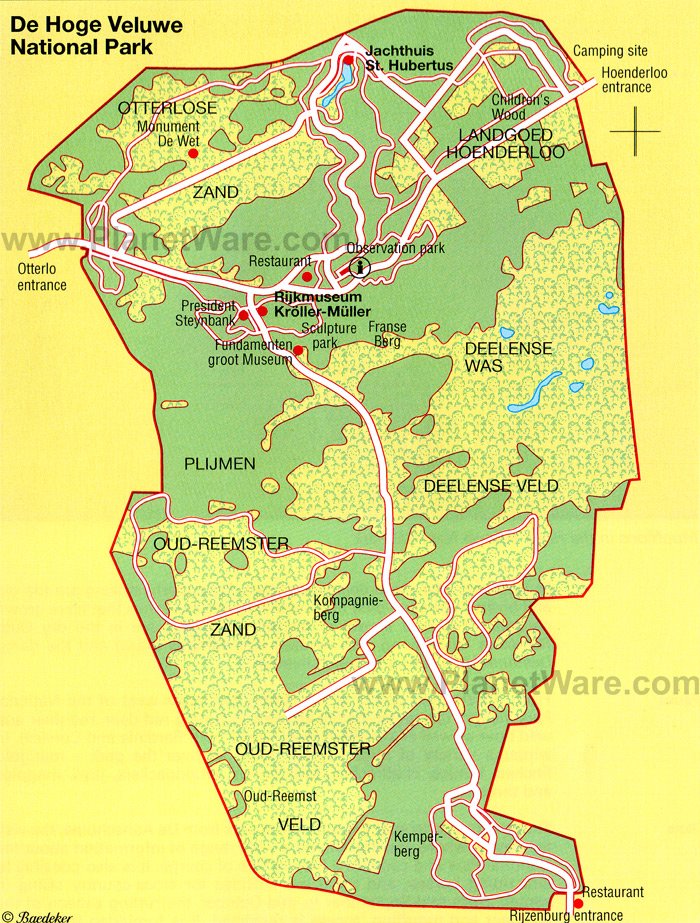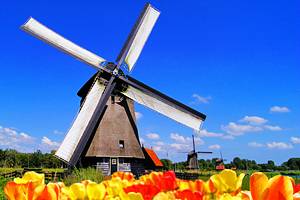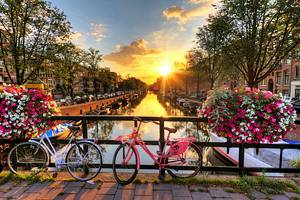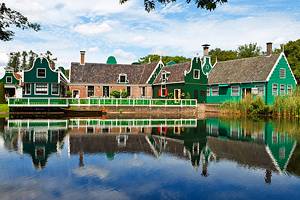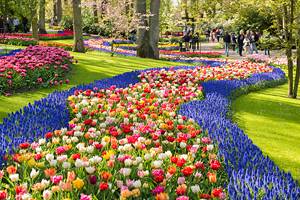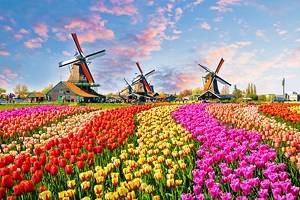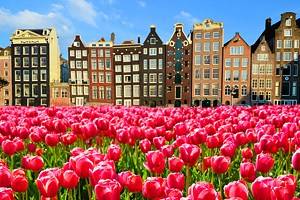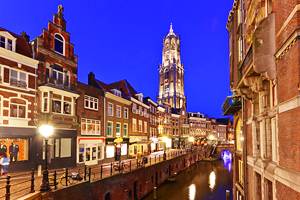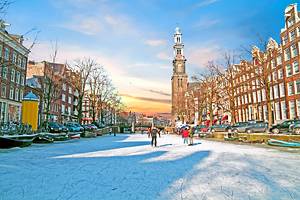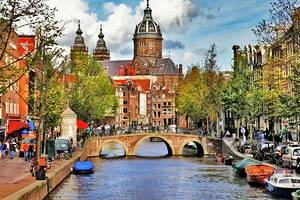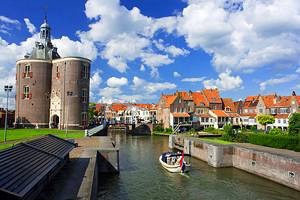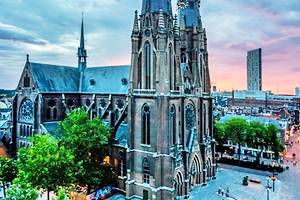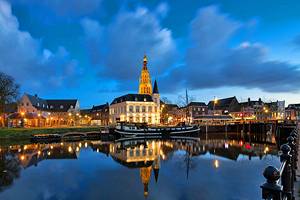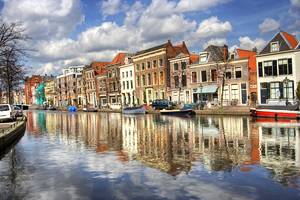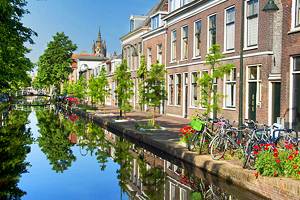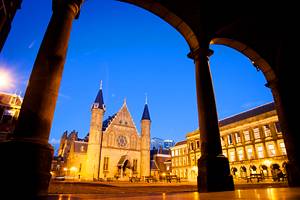Exploring Hoge Veluwe National Park: A Visitor's Guide
Hoge Veluwe National Park (Nationaal Park De Hoge Veluwe), one of the most popular attractions in the Netherlands, lies just eight kilometers north of the city of Arnhem. Occupying an area of 13,750 acres, this huge park is the largest continuous nature reserve in the country and is notable for its diversity of scenery, which includes everything from dense forests to high sand dunes.
It's also unique in being a privately owned national park, one of only two such parks in the Netherlands (and the only one that is fully enclosed). Built as a hunting park between 1909 to 1923, it's now the country's largest nature reserve and is home to an abundance of wildlife, including deer, wild boar, and mouflon (a rare breed of wild sheep).
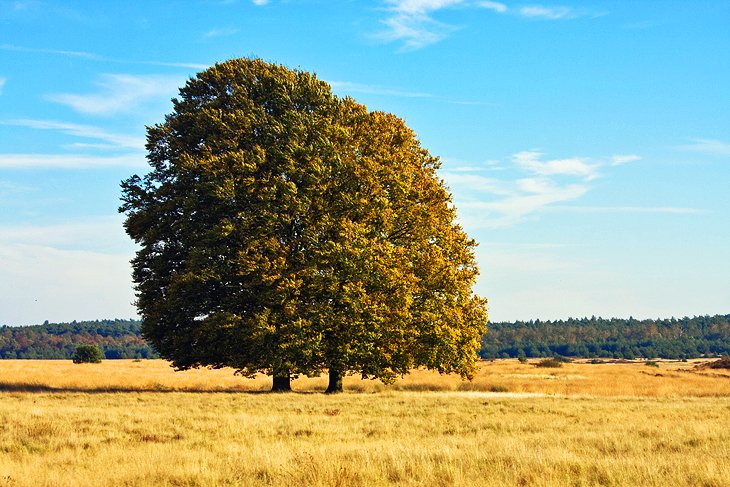
Hoge Veluwe is also an important sanctuary for birds, and has long been a popular destination for bird-watchers. Other popular things to do include cycling and hiking on the many well-marked trails, and the reserve is also home to a sculpture park and art gallery, the Kröller-Müller Museum.
To learn more about Hoge Veluwe National Park in The Netherlands, read through our guide to what is one of the best places to visit in The Netherlands for outdoor activities and nature-inspired adventures.
- Back to Nature: Hoge Veluwe Highlights
- Wildlife Spotting: Hoge Veluwe's Birds and Beasts
- Biking Adventures in Hoge Veluwe
- Take a Hike in Hoge Veluwe
- Home Sweet Home: St. Hubertus
- The Kröller-Müller Museum and Sculpture Garden
- Going Underground: The Museonder
- The Visitor Center & Information Desks
- Touring Hoge Veluwe National Park
- Visiting Tips
- Getting to Hoge Veluwe National Park
- Address
- What's Nearby?
Back to Nature: Hoge Veluwe Highlights
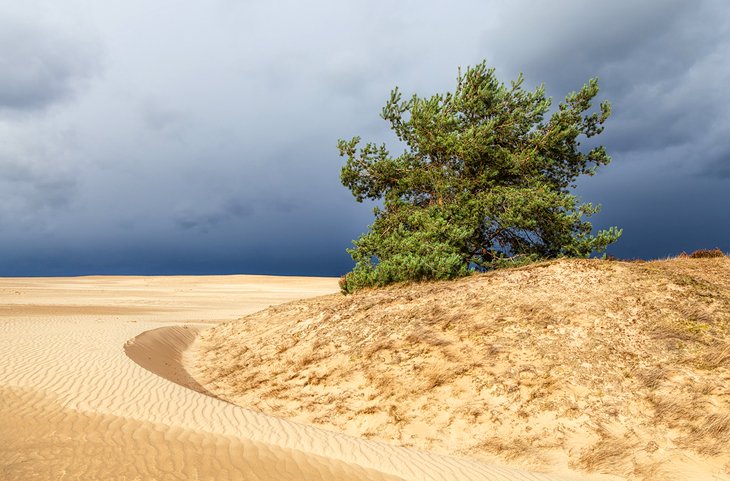
Hoge Veluwe National Park is famous for its tremendous diversity of landscape, which consists of a mix of thick forest, heath, and even sand dunes. Perhaps the best preserved - and certainly the most interesting geologically of the country's national parks - Hoge Veluwe consists of a large area of sandy soil formed during the Ice Age. This fascinating scenery is interrupted in the south and east by moraines (large areas of rocky glacial deposits) standing between 80 and 100 meters high.
Once completely covered in trees, the park gets its present look from the Middle Ages, when patches of forest were cleared for cultivation. The exposed areas and the region's expanses of heathland were used for sheep grazing. Over time, the sand was blown off these bare patches, sometimes burying whole villages, with dunes building up and leaving some areas reduced to wasteland.
In the 19th-century, reforestation schemes were launched to prevent further drifting. Meanwhile, some of the depressions filled with rainwater, forming lakes.
Wildlife Spotting: Hoge Veluwe's Birds and Beasts
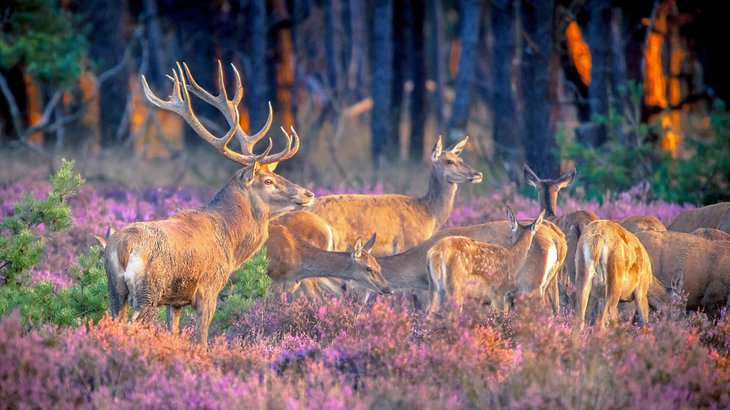
Hoge Veluwe National Park is a wonderful place to visit for those who enjoy bird-watching and wildlife spotting. From well-placed observation points in the center and northwest sections of Hoge Veluwe, visitors can watch a diverse variety of animals, including red deer, roe deer, and wild pigs. Also frequently seen are moufflon, a species of wild sheep originating from Sardinia and Corsica. In winter, a variety of birds congregate in the park, including marigold finches, titmice, chaffinches, woodpeckers, jays, magpies, and thrushes.
If you're here for the wildlife, the best times to do some animal spotting are early morning and late evening, so plan your visit accordingly. Be sure to pick up a park map upon arrival. It provides details regarding locations of wildlife observation posts and refuge areas, some of which are easily accessible by car. These are available from the entrances, visitor center, tea house, or park shop.
For those with an interest in flora, the park is home to some 500 different plant species. Many of these are rare and unique to the region, including numerous fungi, mosses, and lichens. Plant highlights include the protected common juniper; a small insect-eating plant called a sundew; dwarf viper's grass (one of the country's rarest plants); and the lovely marsh gentian, well known for its beautiful blue flowers.
The park also boasts large, dense woodland areas consisting of conifers (particularly pine) along with rhododendrons and numerous species of deciduous trees. It's particularly noted for its abundance of red oaks.
Biking Adventures in Hoge Veluwe
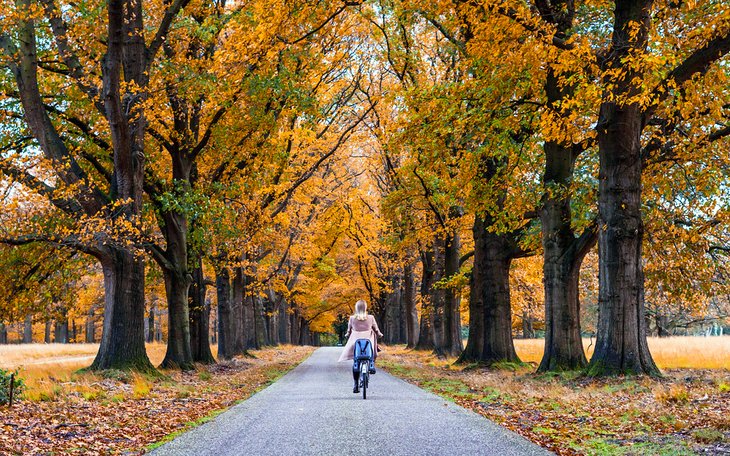
As with so much of the Netherlands, Hoge Veluwe National Park is predominantly flat, making touring by bike one of the best ways to enjoy its magnificent scenery. And as the Netherlands is one of the most bike-friendly nations on the planet, it seems only natural that more than 1,700 of the country's famous White Bikes have been made available for use throughout the park.
Best of all, this fun mode of transport is free with admission to the park. Simply turn up, ride as far as you like, and drop the bike off at one of the convenient distribution points or park entrances when you're done. Specially designed children's bikes are also available, as are versions with front or rear child seats.
For those wanting to hang on to their bike for the duration of the day, lockable Blue Bikes are available for rent from the Bicycle Workshop next to the visitor center. A number of tandem and electric bikes are also available here. For those with special needs, wheelchair bikes and trikes are available free of charge, as are bikes designed for easy mounting. In addition to the three main entrances, White Bikes can be collected from the Marchantplein, the Kröller-Müller Museum, and Jachthuis Sint Hubertus.
Official site: www.hogeveluwe.nl/en/plan-your-trip/walking-and-cycling/cycling
Take a Hike in Hoge Veluwe

Are you looking to take things at a slower, more relaxed pace? Hoge Veluwe National Park also has numerous well-marked rambling routes and footpaths. These easy-to-follow routes are clearly marked (just look for the wooden posts) and take in the park's most picturesque spots, including the wildlife-viewing stations.
Routes range from three to eight kilometers, and a number of self-guided themed walks are available. Whatever route you choose, be sure to collect a map when purchasing your admission ticket. Longer routes of up to 20 kilometers are also available for serious hikers, while those with toddlers can rent special rugged hiking strollers.
Traveling with pets? Don't worry, as dogs are welcome on a leash. Also, convenient rest areas with washroom facilities are located at numerous locations along the most popular routes.
Official site: www.hogeveluwe.nl/en/plan-your-trip/walking-and-cycling/walking
Home Sweet Home: St. Hubertus
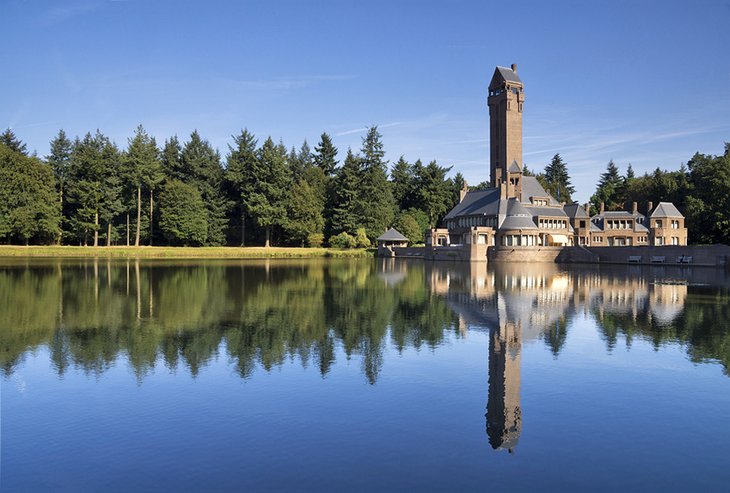
Attractive Jachthuis Sint Hubertus was built as the main residence for Hoge Veluwe's wealthy owners, Anton and Helene Kröller-Müller. Designed by one of the Netherland's leading architects, Hendrik Berlage, it was completed in 1923. Named after St. Hubertus, an accomplished huntsman, this magnificent mansion contains numerous references and symbols relating to the legend of the great saint, most noticeably its antler shape (the masonry also incorporates a cross).
The home was also built with modernity and comfort in mind. As a result, it contains a number of technical innovations that were new for the time, including central heating, central vac, and an electric elevator.
The home is now a museum called Country Residence Museum (Jachthuis Sint Hubertus). Highlights of a visit include displays relating to the building's design, as well as a chance to view the original furnishings. Admission is available only via guided tours (available in English).
Address: Apeldoornseweg 258, 7351 TA Hoenderloo, Netherlands
The Kröller-Müller Museum and Sculpture Garden
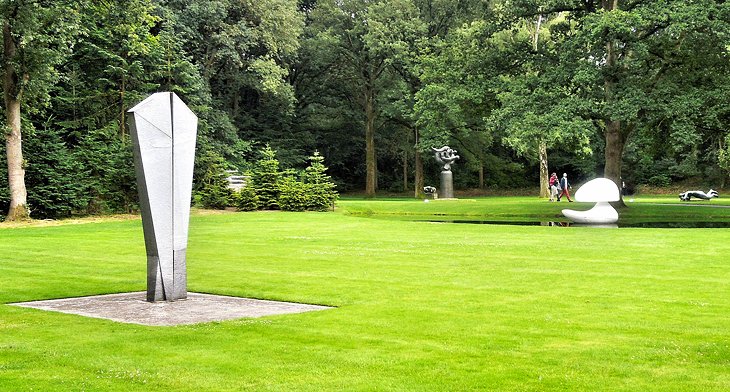
Built to house the private collection of Hoge Veluwe's art collector owners, the Kröller-Müller Museum (Rijksmuseum Kröller-Müller) is home to numerous fine examples of 19th- and 20th-century European art. Built in 1938, the building was designed to bring art and nature together, a concept continued in the impressive glass extension added in 1977.
Highlights of the collection include some 4,000 drawings, 275 sculptures, and several hundred paintings. Work from the late 19th and early 20th centuries predominates, including 280 paintings and drawings by Vincent Van Gogh from his time in The Hague and Paris. Other treasures include Art Nouveau works by Odilon Redon, James Ensor, and Jan Toorop; Impressionism and Expressionism paintings by Edouard Manet, Claude Monet, Paul Cézanne, and Auguste Renoir; and Cubism, including examples from Pablo Picasso and Fernand Léger.
The extension to the museum displays sculpture, reliefs, and drawings since 1950. Also worth seeing is the superb Sculpture Garden, which has works by Auguste Rodin, Barbara Hepworth, and Aristide Maillol. The museum also runs a series of fun art programs for kids, as well as concerts. English language guided tours are available.
Address: Houtkampweg 6, 6731 AW Otterlo, Netherlands
Official site: https://krollermuller.nl/en
Going Underground: The Museonder
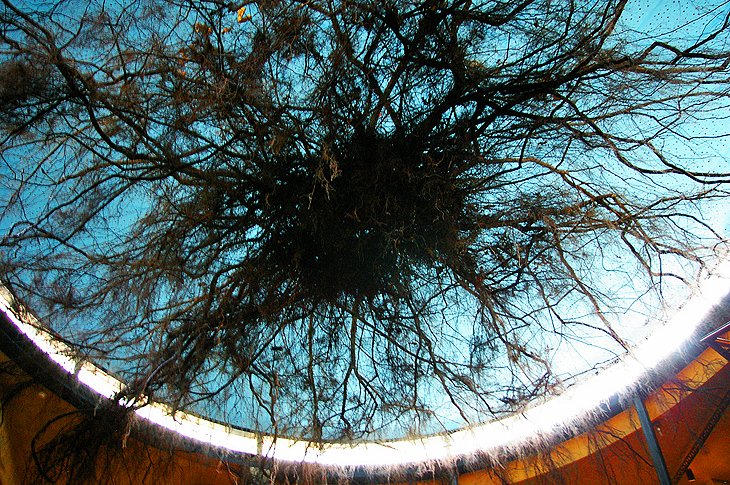
Europe's first underground museum, the Museonder opened near the Kröller-Müller Museum in 1993. Visitors are taken on a unique journey through a series of subterranean pathways providing displays and information related to the area's natural history and geology.
Exhibits also cover once-native wildlife from the region's past, including the skeletons of mammoths, rhinos, and giant stags. Some exhibits focus on organisms that live underground, including burrowing animals and insects, and the root systems of trees.
Address: Houtkampweg 9c, 6731 AV Otterlo, Netherlands
The Visitor Center & Information Desks
The visitor center at Hoge Veluwe National Park is the best place to begin your adventure. In addition to providing useful, practical information about exploring the park, its numerous displays include a fascinating glimpse at the park's stunning landscape, its wildlife, and other features you'll see along the way.
The majority of the park's themed walking and cycling tours also start here, and be sure to check out the movies showing in the auditorium, including special films just for kids. The park shop is also here and offers everything from unique gifts and souvenirs to food items such as honey and truffles. Also worth noting is the fact a number of smaller information desks are located throughout the park, and are clearly marked on trails and on the park's useful maps.
Official site: www.hogeveluwe.nl/en/plan-your-trip/information-desks
Touring Hoge Veluwe National Park
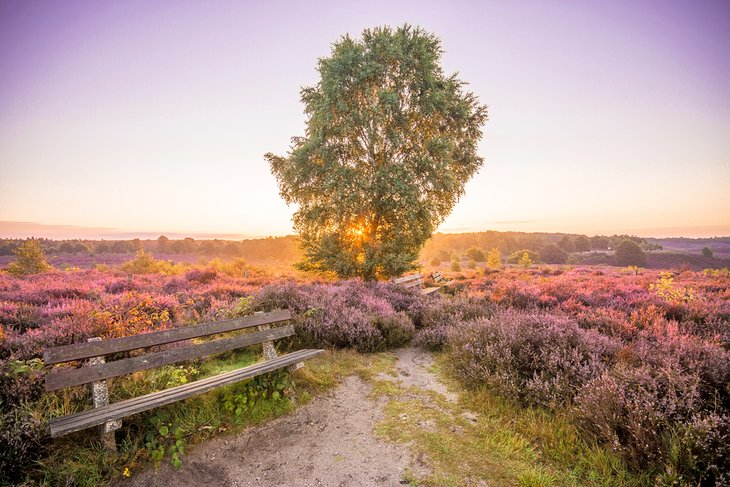
Access to Hoge Veluwe is via one of its three entrances: Koningsweg 17, Schaarsbergen; Houtkampweg 13, Hoenderloo; and Houtkampweg 9, Otterlo. Once in, head for the visitor center for maps and other information. Guided tours can be purchased here or at the entrance gates, along with English-language audio guides.
Visiting Tips
Dining:
- A number of on-site dining opportunities are available in the park, including De Koperen Kop, offering a variety of self-service meals (lunch and dinner), along with a pleasant terrace and a playground for the kids. Lunches and snacks are available from Monsieur Jacques Café-Restaurant in the Kröller-Müller Museum, while light refreshments are offered at Tea House Jachthuis Sint Hubertus.
Camping:
- On-site camping is available for tents or caravans, with wash and shower facilities provided for a small additional fee (optional electric hookups are also available).
Getting to Hoge Veluwe National Park
- By Bus: Buses run regularly from Apeldoorn train station (Route 108 to Hoenderloo; change to Route 106 to Otterlo). Buses stop in the park near the visitor center and the Kröller-Müller Museum.
- By Train: Hoge Veluwe is served by trains to Apeldoorn.
- By Road: Hoge Veluwe is an easy drive from Arnhem and Apeldoorn, with entrances at Schaarsbergen (south), Otterlo (northwest), and Hoenderloo (northeast).
Address
- Koningsweg 17, Schaarsbergen, Netherlands
- Official site: www.hogeveluwe.nl/en/14
What's Nearby?
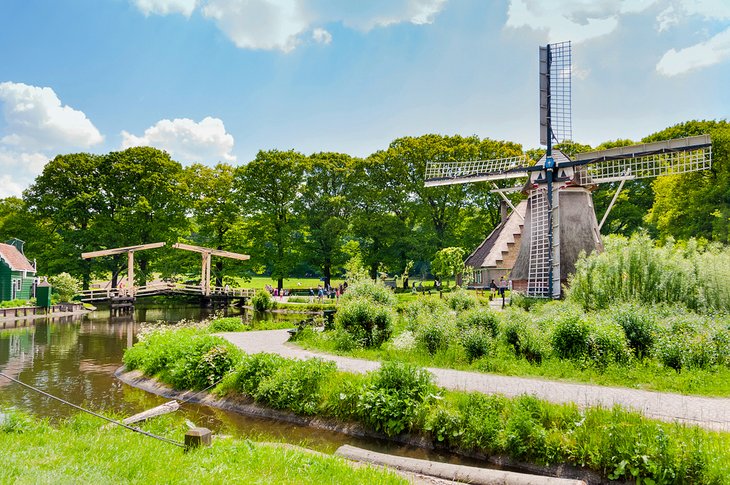
The majority of tourist attractions within an easy drive of Hoge Veluwe National Park are in or around Arnhem, eight kilometers away. Must-sees include the Netherlands Open Air Museum (Nederlands Openluchtmuseum), an 82-acre site including traditional farms and homes, and the popular Royal Burgers' Zoo, home to more than 2,000 animals and one of the largest zoos in the country.
Things to do in Arnhem itself include visiting the city's famous John Frost Bridge, named after the commander of the British paratroopers who held the crossing against huge odds, and Airborne Museum Hartenstein, housed in the 19th-century villa that served as Frost's headquarters.
If you're heading north from Hoge Veluwe, toward Apeldoorn - and you're traveling with younger children - make sure you visit Koningin Juliana Toren, a fun amusement park built around the historic Queen Juliana Tower from 1910. Highlights of the park's 60 attractions include roller coasters, merry-go-rounds, and a variety of wet rides.
